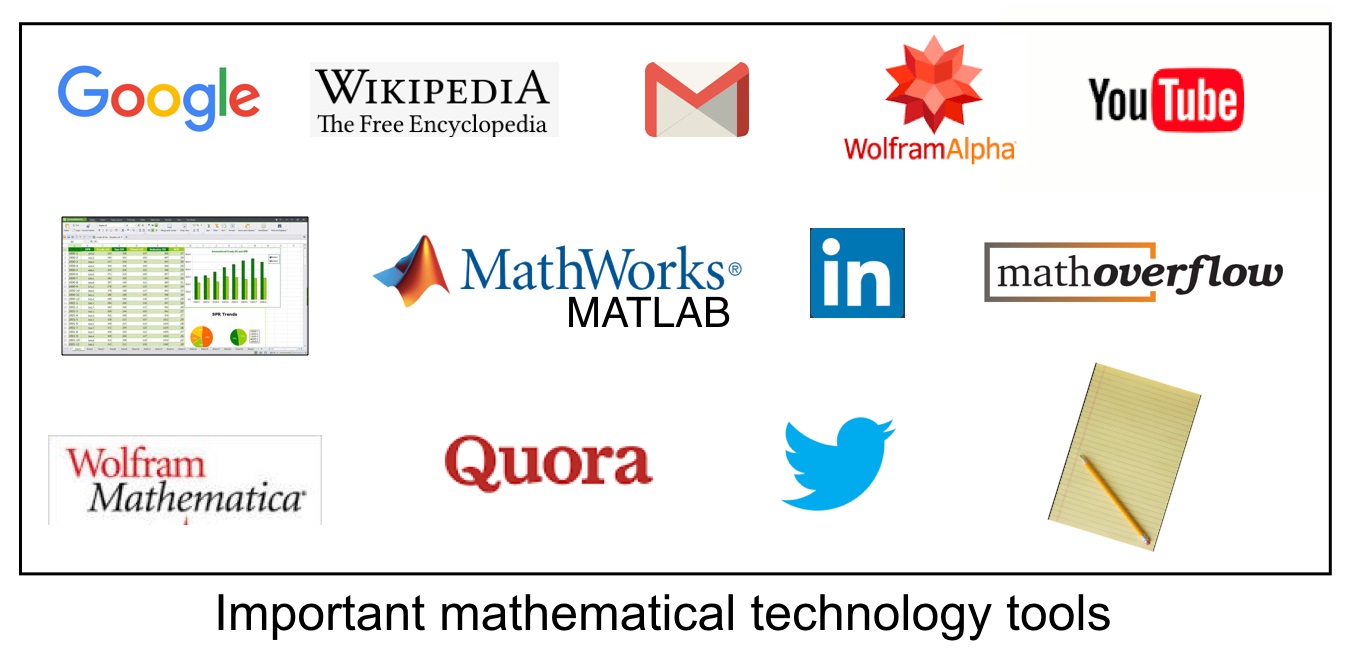The image below reflects a workflow that Keith Devlin, a retired mathematics professor from Stanford University – uses when he is working on solving a math problem. In his experience, many mathematicians have similar workflows.

Let’s say he is working on solving a new and unfamiliar problem. A line of attack, strategy, or tool may not immediately come to mind, so he goes through the process roughly outlined here.
Workflow Mathematicians Use to Solve Math Problems
A mathematician’s workflow:
- Google the problem or the field of mathematics.
- Consult Wikipedia to see what it has to say about this problem or this class of problems.
- Email other mathematicians who might have worked in a similar area before or even on the same problem.
- Watch YouTube videos about the type of problem.
- Use the powerful Wolfram Engine, MathWorks, Mathematica, or other knowledge engines to work on the problem.
- Consult with others on Math Overflow.
- If all else fails, do some calculations.
This glimpse into the life of a working mathematician shows that mathematics is no longer a solitary endeavor—if it ever was. In developing his own ideas for solving a problem, Devlin begins by seeing what ideas others have had on the same problem, similar problems, or in the same branch of mathematics. The solitary work happens later, but it is often aided by technology with tools like the Wolfram engine.
The level of access to the thoughts and ideas of others we now have in the Internet era is unprecedented in human history. Before, we were limited by library access to physical books or journals, but we can now access all of this and more through our own computers.
Workflow Students Use to Solve Math Problems
Here is a typical workflow for a student in kindergarten through 12th grade:
- Start working on the problem, alone or with others, by attempting to think of a strategy that will help with the problem.
- Do some calculations that the student thinks might help solve the problem.
- If all else fails, ask the teacher for help.
A student’s workflow often looks highly individual and leaves students with nowhere to go if they are stuck. Teacher mentorship, coaching and feedback will help, as that is their job. But as novice mathematics learners, students can also develop a collaborative and more technology-driven workflow, when necessary.
In part, the stark difference in workflow reflects a novice and expert divide. Students often learn specific mathematics tools and ideas by working on problems. They have far less in the way of knowledge to draw upon in their work. Some of the tools Devlin uses might get in the way or disrupt the teacher’s intended learning goal. Further, unlike for Devlin, students are graded at the end of units of study, which means they must be assessed individually on their knowledge and skills.
That said, integrating technology in the math classroom can help students in their work, and there are also strategies to introduce a collaborative approach to the doing of mathematics. Collaborating on interesting problems is something that students should be doing, as often as possible; and by considering Devlin’s approach, teachers have a powerful opportunity to help their students use technology to work collaboratively and augment their own learning.
A Better Approach to Tech Integration in Math Class
Here are some ideas for how a workflow might work with math tools for students, discarding the more professional tools from Devlin’s list, and adapting his ideas for elementary and secondary schools.
1. Working with Peers
Consult with other students, while working on the problem. This can be asynchronous, if you consider how most school boards now have access to learning management systems.
Google Classroom, for example, is commonly used in many places. Teachers can post the problem in Google Classroom and have students share ideas amongst themselves for how to approach the problem, adding links that are of interest or that might help.
2. Watching YouTube Videos
Video is ubiquitous. Consult YouTube videos for more information on the topic. For example, if you are working on a problem about the Pythagorean Relationship, watch a few videos about the discovery of the theorem and instructional videos about how to solve Pythagorean problems.
In my experience, kids often think Googling is just for entertainment, but there is a wealth of powerful instructional videos out there to help students get unstuck.
3. Using Online Tools
- Online manipulatives: Mathies is an example of a website where students can use specific tools to “do the work”. An example is the pattern block tool, the fraction strips tool, or the number line tool. Screen captures are powerful ways to share their solutions with others.
- “Draw on the Screen” Programs: Examples here might include working on paper or taking photographs, for example with iOS picture tools or simple apps like the Mathies Notebook app. From here, it is a short step to uploading their work to Google Classroom or another platform and creating a kind of digital portfolio.
- PhotoMath: Use apps like PhotoMath to take a picture of the problem, let the app solve it, and work backwards to reverse engineer the solution. This is particularly effective when you are stuck. “Start from the answer” is not historically a common school math strategy, but it can work. These apps exist in a blurry area between “doing the work” and “cheating,” but we can use them powerfully to our benefit.
4. Tweeting
Use a class Twitter account to share solutions with the world and ask for advice or assistance. You could also make this an “ask the expert” activity if you are able to set up a Google Meet or Skype with a working mathematician.
Schools have barely begun to tap into the promise of integrating technology in the math classroom. Mathematics, at the professional level, has turned into an intensely collaborative activity, with unsolved problems being posted to forums for all to work on. The stereotype of the lone genius working on a blackboard still exists, and perhaps drives some away from mathematics as a profession.
Students can learn to collaborate in interesting ways on mathematical problems from a young age. Teachers will find the appropriate balance between collaborative work and individual assessment. It is also up to the teachers to determine what sort of math tools for students will be used and when.
My hypothesis is that students can develop more modern workflows with technology integration in the math classroom. The typical interactions students have in our mathematics classrooms are between themselves and a notebook or paper or themselves and a teacher. Students can be taught to see mathematics as a collaborative and technological activity. Many tools, programs, websites, platforms, and apps for students exist to help our novice mathematicians as they learn and grow.
This article was originally published in September 2019 by Learning.com, and has been updated.

Matthew Oldridge
Staff Writers
Matthew Oldridge is a mathematics educator, TEDx Speaker, and author of Teaching Mathematics Through Problem-Solving in K-12 Classrooms.
Further Reading
What Is Digital Citizenship? Key Skills & Best Practices for Students
In a world dominated by virtual interactions, being a responsible digital citizen has never been more crucial. Students today grow up with social...
Teaching Children How to Effectively Handle Cyberbullying
In today’s digital age, online safety is a critical concern for children navigating the internet. While the internet provides endless opportunities...
Examples of Abstraction in Everyday Life: How Students Already Use Computational Thinking
Computational thinking, though often perceived as a concept limited to technology or coding, is a valuable problem-solving skill that students...




